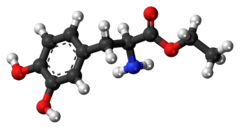Etilevodopa
Appearance
From Wikipedia, the free encyclopedia
This is an old revision of this page, as edited by DMacks (talk | contribs) at 04:10, 22 June 2020 (Remove malformatted |molecular_weight= when infobox can autocalculate it, per Wikipedia talk:WikiProject Pharmacology#Molecular weights in drugboxes (via WP:JWB)). The present address (URL) is a permanent link to this revision, which may differ significantly from the current revision.
Revision as of 04:10, 22 June 2020 by DMacks (talk | contribs) (Remove malformatted |molecular_weight= when infobox can autocalculate it, per Wikipedia talk:WikiProject Pharmacology#Molecular weights in drugboxes (via WP:JWB))
 | |
 | |
| Clinical data | |
|---|---|
| ATC code |
|
| Identifiers | |
| |
| CAS Number | |
| PubChem CID | |
| ChemSpider |
|
| UNII | |
| KEGG |
|
| CompTox Dashboard (EPA) | |
| ECHA InfoCard | 100.223.003 |
| Chemical and physical data | |
| Formula | C11H15NO4 |
| Molar mass | 225.244 g·mol−1 |
| 3D model (JSmol) | |
| |
| |
| (verify) | |
Etilevodopa (TV-1203) is a dopaminergic agent which was developed as a treatment for Parkinson's disease.[1] It is the ethyl ester of levodopa. It was never marketed.
See also
References
- ^ Djaldetti R, Giladi N, Hassin-Baer S, Shabtai H, Melamed E (November–December 2003). "Pharmacokinetics of etilevodopa compared to levodopa in patients with Parkinson's disease: an open-label, randomized, crossover study". Clinical Neuropharmacology. 26 (6): 322–6. doi:10.1097/00002826-200311000-00012. PMID 14646613.
| Dopaminergics |
| ||||||||||
|---|---|---|---|---|---|---|---|---|---|---|---|
| Anticholinergics | |||||||||||
| Others |
| ||||||||||
| |||||||||||
| Phenethylamines |
|
|---|---|
| Amphetamines |
|
| Phentermines |
|
| Cathinones |
|
| Phenylisobutylamines | |
| Phenylalkylpyrrolidines | |
| Catecholamines (and close relatives) |
|
| Miscellaneous |
|
This drug article relating to the nervous system is a stub. You can help Wikipedia by expanding it. |
